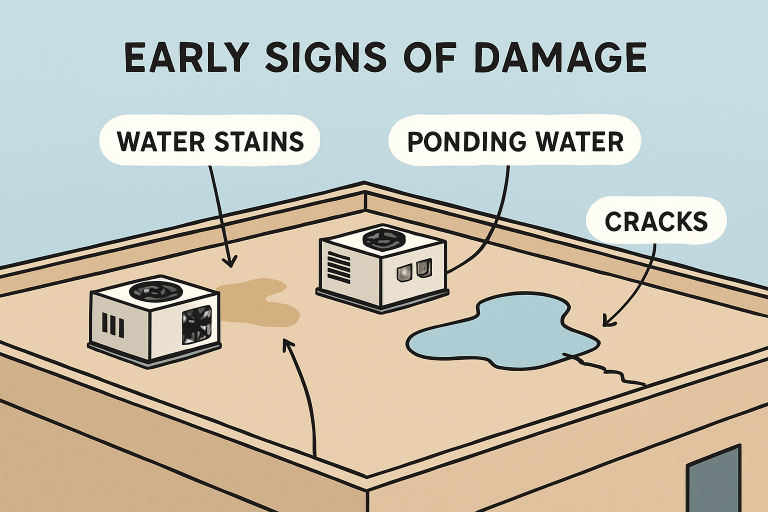Key Takeaways
- Early detection of commercial roof issues prevents major repairs.
- Signs like water stains, ponding water, and cracks should be treated immediately.
- Regular roof inspection and maintenance are vital for longevity and occupant safety.
- Expert guidance helps in maintaining the roof’s integrity and energy efficiency.
Introduction
For business owners, maintaining the durability of your commercial roof safeguards your investments and the well-being of everyone inside. Overlooking even minor issues can quickly escalate into costly repairs, business disruptions, and long-term damage. Early identification of potential problems is essential, and proper attention can help extend the lifespan of your roof. As a leading resource, https://www.deltaservices.com/ provides expert insights and helpful maintenance services to address issues before they escalate into emergencies.
Routine inspections and monitoring enable facility managers and property owners to make informed, proactive decisions. Understanding the warning signs of roof damage strengthens your maintenance strategy and prevents unexpected expenditures.
1. Water Stains and Leaks
One of the most common concerns for commercial properties is the sudden appearance of water stains on ceilings or walls. These stained patches often suggest roof leaks directly above or nearby. Ignoring them can result in structural deterioration, mold growth, and compromised air quality. Scheduling routine inspections ensures any leaks are detected and repaired early, minimizing disruption and damage.
2. Ponding Water
Flat commercial roofs are prone to areas where water pools after rainfall and remains for over 48 hours. This “ponding” is typically caused by drainage issues, blocked gutters, or aging roof surfaces. Prolonged ponding accelerates the aging of roofing materials and increases the risk of new leaks. If left unresolved, it can lead to severe structural problems, weakening the roof deck and support system.
3. Blistering or Bubbling on the Roof Surface
Bubbles or blisters form when moisture or air becomes trapped under the roofing membrane. Poor installation, temperature fluctuations, or inferior materials are usually to blame. These imperfections degrade the roofing integrity, eventually leading to leaks and more severe material displacement. Early detection and timely repairs can hinder widespread water infiltration and save repair costs.
4. Cracks or Tears in the Roofing Material
Harsh sunlight, fluctuating temperatures, and physical stressors often cause roofing materials to crack, split, or tear. While minor cracks might seem insignificant, they can quickly widen and create direct pathways for water to reach insulation layers and structural components. Addressing small issues during regular inspections is more affordable and less disruptive than dealing with emergency repairs after significant rainfall or storms.
5. Loose or Missing Flashing
Flashing acts as a sealant around roof joints, edges, or penetrations, such as vents and HVAC units. When it becomes loose, warped, or is missing entirely, these vulnerable spots are exposed to water entry. Strong winds, heavy rains, or improper installation can dislodge flashing over time. Regular inspection and replacement of compromised flashing are crucial in preventing major leaks.
6. Mold, Mildew, or Algae Growth
Noticing green, black, or white growths on your roof could be an indicator of excess moisture retention, which can weaken roofing materials. Mold, mildew, and algae also create slip hazards and potential health issues for building occupants. According to This Old House, regular cleaning and proper maintenance are key to removing algae and preventing its return. Implementing routine cleaning and ensuring clear roof drainage paths can mitigate organic growth and protect everyone using the premises.
7. Increased Energy Bills
An unexpected spike in heating or cooling expenses could be a hidden sign that your roof is no longer regulating indoor temperature effectively. Damaged insulation, leaks, or worn roofing materials allow conditioned air to escape, forcing HVAC systems to work harder to maintain a comfortable temperature. Addressing the root cause of inefficiency can optimize energy use and improve overall comfort for building occupants.
8. Structural Sagging
A sagging roof signals potentially critical issues such as waterlogged insulation, weakened deck structures, or overloaded rooftops. This is a red flag that warrants immediate attention from a roofing professional. If left unattended, a sagging roof could collapse, posing a risk to safety and potentially disrupting business operations. Proactive engagement with experts can determine the best remedial action for sagging or stressed structures.
Maintaining Your Commercial Roof
Staying alert to early warning signs and acting swiftly is paramount to securing your commercial roof’s long-term health. Schedule regular professional inspections, maintain detailed records, and promptly address any visible issues. Proactive attention pays off in extended lifespan, lower repair expenses, and sustained safety for all building occupants. By leveraging expert services and reliable maintenance checklists, you can confidently protect your business investment for years to come.







